
Greg Bond / OPB
State of Wonder is taking a year-long journey through architecture, planning and design with columnist-in-residence Randy Gragg. Formerly an architecture critic at The Oregonian and editor-in-chief at Portland Monthly, Gragg is now the executive director of the John Yeon Center for Architecture and the Landscape at the University of Oregon.
No one is more thoroughly steeped in the design character of Portland or more highly attuned to how the urban landscape here is changing.
Join him throughout 2016, as he hits the streets to cover the state of the built environment.
February 2017

Bruce Forster
Portland's Aerial Tram: From Controversy To Icon
It’s hard to believe Portland’s aerial tram just turned 10. What started as a controversy has grown into an icon, not to mention a major driver of residential and commercial development in the South Waterfront. We hop aboard to look back on the transformation and gaze into the tram's future.
January 2017
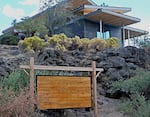
Desert Rain, the first house in the world certified for the Living Building Challenge.
Courtesy of Tom Elliott and Barbara Cook
Desert Rain: Meeting the Living Building Challenge
Can a house be more than a place to live? Can it be a demonstration of our highest aspirations? Meet Tom Elliott and Barbara Scott of Bend. Their house, Desert Rain, was made to meet certification of the Living Building Challenge using the highest standards for energy efficiency, power generation, water systems management and more.
December

Colonel Christian Reese at the new Col. James Nesmith Readiness Center in Dallas, Oregon.
Randy Gragg / OPB
New National Guard Armory Is A Model Of Architecture
Many of Oregon’s National Guard armories are old, barely functioning, and sorely in need of safety updates, but Oregon also has a couple of new armories — now called National Guard Readiness Centers. They have big rooms for training like the old ones, industrial kitchens and firing ranges (only they use guns connected to virtual reality computers). The newest one, the Colonel James Nesmith Readiness Center for the 162nd Engineer Company of the Oregon National Guard in Dallas, Oregon, also has great architecture.
November
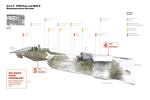
The Architecture Firm that's Transforming Portland's Waterfront
Good news and bad in the global architecture firm Snohetta's quest to transform Portland's waterfront. First, the bad: the James Beard Market got booted from its home at the base of the Morrison Bridge, meaning it's once again homeless. But in good news, the partners behind the Willamette Falls Riverwalk at the old Blue Heron Mill in Oregon City have raised $19 of $25 million for the first phase, and Snohetta is deep in the design process with the public, which includes, well, games.
October
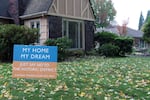
Members of Keep Eastmoreland Free are fighting to prevent their neighborhood (and thereby their homes) from being turned into a historic district.
Aaron Scott / OPB
Can a Stranger Designate Your House Your House as Historic? In Oregon, They Can.
Generally, only the owner of a house can nominate it to the National Register of Historic Places, but locally there's a loop hole: Anyone has the ability to lobby the Portland Landmarks Commission and National Park Service to make an entire neighborhood historic. If an effort by the Eastmoreland Neighborhood Association to create a new national historic district is successful, hundreds of property owners could find their houses listed on the registry — with all the rules and regulations it applies — whether they want it or not. And many don't.
September
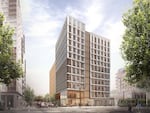
Lever Architecture has cleared design review to build an 11-story, mixed-use tower in the Pearl using cross-laminated timber in place of steel and concrete—the tallest in the nation.
Courtesy of Lever Architecture
Future Highrises Made of Wood?
Among all the buildings going up in the biggest boom in Portland real estate history, only one of them can be called the first of its kind in the nation. It’s a simple four-story building called Albina Yard. Instead of steel and concrete, the floors, ceilings and columns that make up this building are made of cross-laminated timber, or CLT for short. This is how CLT stands to revolutionize construction, offering a pre-fabricated material that is faster to build, more resistant to earthquakes, and more sustainable than traditional practices.
August
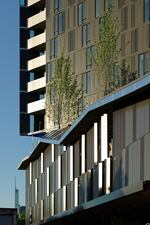
Architect Jeff Kovel says of Yard’s window wall system, “We worked to really integrate the ventilation, elevate the details of the system. The grid in the patters is really unique to Portland and this system."
Courtesy of Wes Pope
Skylab Builds Portland A Brand New Yard
Not since Big Pink or the Interstate Bank tower has Portland produced a high-rise that so many people have opinions about. We’re talking about Yard, the chocolate-brown, 21-story apartment tower recently finished at the east end of the Burnside Bridgehead. Why did the designers shape it this way? We spoke with the architect, Jeff Kovel, about what drove the form of the building.
July
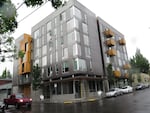
Millennials are often the residents and renters at the new Infill buildings in Portland, like Don Vallaster's Lower Burnside Lofts.
April Baer/OPB
Peeling Back Layers On Portland's Infill Development
Exponential growth in Portland’s neighborhoods have left a lot of people feeling like there’s a big new building popping up on every corner. Gragg explores how architects differentiate between a good and a bad building, what stands in the way of good design and infill development — with a focus on the new Lower Burnside Lofts by one architect who gets it right: Don Vallaster.

State of Wonder columnist-in-residence Randy Gragg talks with architect Eugene Sandoval, principal, ZGF Architects, about Indigo @ twelve | west.
April Baer/OPB.
3 New High-Rises Raise Portland's Skyline
Portland is growing up. Fast. More than 60 buildings over 100-feet tall are in the pipeline, along with a few towering higher than 200 feet. Downtown’s largest property owner, the Goodman family, recently made a highly speculative proposal for four new towers that could rise as high as 460 feet. Gragg talks with the architects of three of the most prominent new buildings: Park Avenue West, the Cosmopolitan and Indigo @ twelve|west.
April

Portland, Oregon
OPB
Portland And San Francisco: Gil Kelley On Parallel Planning Worlds
What can Portland learn from San Francisco? Gragg sits down with Gil Kelley, San Francisco’s citywide planning director — and former director of Portland’s Bureau of Planning and Sustainability — to compare how the two cities approach urban planning.

Preliminary designs for the James Beard Market at the base of the Morrison Bridge by the Norwegian architecture firm Snøhetta.
Courtesy of Snøhetta
An International Architecture Firm Wants To Reshape Portland
Enter the world of Snøhetta, an internationally-renowned architecture firm (think Times Square, the new SF Museum of Modern Art and the Library of Alexandria) about to embark on two projects in Oregon: the James Beard Public Market in Portland and the Willamette Falls Riverwalk in Oregon City (and, announced in October, a 16-acre riverfront master plan for the Oregon Museum of Science and Industry).
February
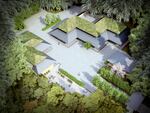
Starchitect Kengo Kuma's design for the new Japanese Garden's Cultural Crossing.
Courtesy of Kengo Kuma Associates
Architect Kengo Kuma's Plans For The Portland Japanese Garden
Internationally renowned architect Kengo Kuma will transform Portland’s Japanese Garden into a stunning, one-of-a-kind village. He gives Gragg a tour of the site.

Randy Gragg and Mayoral Candidate Jules Bailey in southeast Portland.
Greg Bond / OPB
Mayoral Candidate Walk-And-Talks
Candidates Ted Wheeler and Jules Bailey take to the streets with Gragg to explore Portland architecture and talk about what works — and what doesn't.